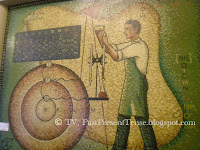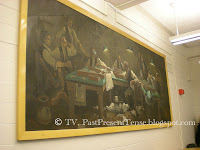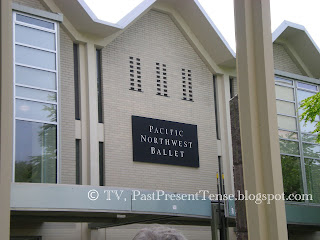As I mentioned before, the third and fourth floors aren't full floors -- they're almost like exhibit boxes floating above the main floor. The third floor, the Linda and Ted Johnson Family Community Gallery, is another space for a temporary exhibit. Right now, the exhibit is "Punctum/Poetry," featuring work of high school students. There are poems written by Seattle high-schoolers, some based on pictures from MOHAI's photo collection; one wall also has three video screens showing videos of students interviewing each other with basic oral history interview questions -- "What do you want to be?" "Where do you see yourself in 10 years?", that sort of thing. Considering the Shaping Our City tower and the Personal Stories tower, MOHAI seems to be really in to gathering stories from people -- everyone, even commoners like us -- to keep for all time. That's pretty cool.
The fourth, and final, floor is the McCurdy Family Maritime Gallery. True to its name, this room is all about boats and boat life. There's a little display about Foss Maritime, and lots of pictures of boats and waterways in Seattle (to go along with the photos on the second floor, just after the Seattle's Great Fire exhibit). The two major items in the gallery are a Fresnel lens from the lighthouse on Smith Island, which guided sailors from 1885 to 1957, and a periscope. Not only is the city of Seattle, with all its lakes and maritime history, a great place to have a periscope, but MOHAI's new location -- right on a lake with lots of boats, near hills with big trees and fancy houses, a major freeway, and just blocks from the Space Needle and Seattle Center -- is a great place to have a periscope, so you can see the enchanting city outside, from inside. Even on that limited opening day, though, there was a line to play with the periscope, so if you go, be patient (especially when little kids don't realize there's a line of people waiting, and just run up to it and throw themselves at it).
One especially cool thing about MOHAI's new location is that it's on the water. Well, duh, I know, it's on a lake; but when a city's history is largely based on water travel and the many uses of major waterways, it hits home more when you can look right outside the window (which the building has plenty of) and actually see the water. From the windows on the second floor, you look out and you're looking almost directly into boats. From the windows in the Maritime Gallery, the entire view is water and boats (and the pretty city beyond the lake). It's all pretty well-placed, and MOHAI takes advantage of its location (Coincidence? Rule #39).
 |
| View from the second floor |
So, that wraps up our visit to the Museum of History and Industry. I'm really impressed with the new location, and what they've done with it. I don't think it's just the sparkle of something new; I think everything will last and hold up well. Plus, everything was planned well: there are lots of places to sit if you need a little break from all of the walking around, there are lots of touch screens and other interactive displays for both kids and adults to play with, and there's a cellphone audio tour for 13 items in the collection.
Even though we spent five hours at the museum, I KNOW we didn't see everything. The films that run on loops in various exhibits, every picture, every display in every nook and cranny, every word on every sign... I KNOW we didn't see everything. But I can't wait to see what they do when they rotate items in and out. So much to explore!
And one more news item:
Seattle Times photo gallery



























